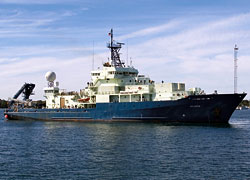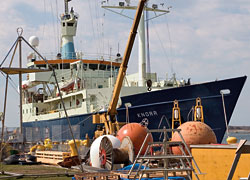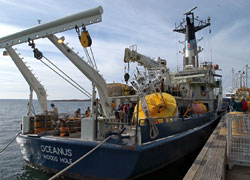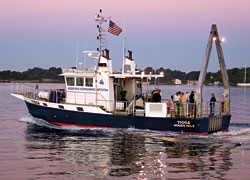|
|
|
Cruise Summaries |
|
 Atlantis and Alvin
Atlantis and Alvin
Days at sea: 241
Cruises: 9
Investigators served: 207
Nautical miles: 22,852
Alvin dives: 82
In January, for the first time, the submersible Alvin
and the tethered vehicle Jason 2 were deployed off
Atlantis on the same leg in the eastern Pacific to
study a deep rift in the seafloor where ocean crust could
be observed and sampled. After supporting chemistry, biology,
and geology research at the East Pacific Rise, Galapágos Rift,
and Juan de Fuca Ridge, Atlantis returned at year
end to Woods Hole for maintenance. It was a rare homecoming,
marking just the third homeport visit since the ship’s 1996
launch.
|
 Knorr
Knorr
Days at sea: 179
Cruises: 5
Investigators served: 96
Nautical miles: 33,093
Knorr spent 8 weeks in early 2005 at a dry dock for
installation of new decking and fittings for a 150-foot (45-meter)
sediment corer. When complete it will be among the world’s
longest corers in operation. The vessel went on to log the
most miles of the four WHOI vessels. Research took Knorr
to the western and mid-Atlantic, where scientists conducted
climate change studies and deployed moorings. In the equatorial
and southern Pacific, scientists sampled the water column
and studied currents flowing from the Antarctic. |
 Oceanus
Oceanus
Days at sea: 241
Cruises: 16
Investigators served: 205
Nautical miles: 29,909
In 2005 Oceanus celebrated its 30th year of operations.
Researchers on Oceanus spent much of the year focused
on marine plankton—some menaces, others curiosities. In spring,
researchers sailing from Boston Harbor to the Bay of Fundy
detected signs of what would become an historic bloom of harmful
algae, popularly known as red tide. From June until September
the ship carried biologists and physical oceanographers into
the Sargasso Sea to study phytoplankton blooms that occur
as a result of swirling currents, called eddies. |
 Tioga
Tioga
Days at sea: 132
Trips for education: 8
Passengers: 710
The coastal research vessel Tioga, launched in 2004,
supported its first full year of science research and education
efforts in New England, working as far north as the Merrimack
River on the New Hampshire border and sailing as far south
as the New Jersey coast. The 60-foot (18-meter) vessel proved
ideal for engineers testing and deploying oceanographic instruments,
including gliders, moorings, and buoys. Biologists used the
vessel to scout for and eventually tag and monitor several
endangered right whales. In September, one biologist used
the vessel 24 miles offshore Nantucket to perform a rare partial
whale necropsy at sea.
|
|
|
Copyright ©2006 Woods Hole Oceanographic Institution,
All Rights Reserved.
Mail: Woods Hole Oceanographic Institution, 266 Woods Hole Road, Woods Hole,
MA 02543, USA.
E-Contact: info@whoi.edu; press relations: media@whoi.edu,
tel. (508) 457-2000
Home | Site Map | Contact
|

